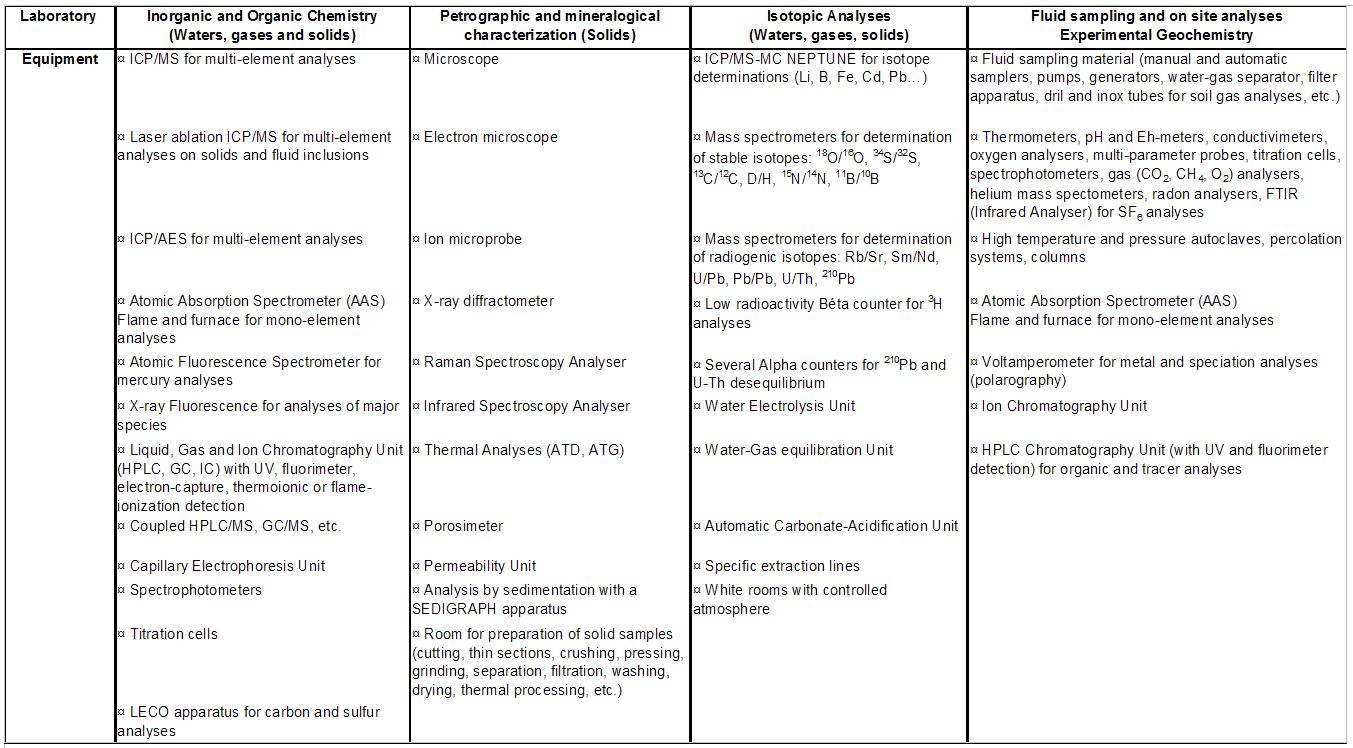|
Activities With a staff of about 65 engineers and technicians, and four main laboratories (see enclosed table, space of about 2,000 m2), the BRGM "Metrology, Monitoring, Analysis" Division may perform numerous and diversified analyses of waters, gases and solids (rocks, soils, minerals, sediments, ores, materials) for geothermal applications (geochemical fluid monitoring, tracer tests, geochemical exploration, etc.). This division has more than 30 years of experience and knowledge in the geochemical studies applied to the low and high temperature geothermal field (Paris Basin, Soultz-sous-Forêts, Cézallier, Limagne, Bouillante, Martinica, La Réunion, Chile, Djibouti, Azores, etc.). This division works with the ISO 9001 Quality Control System, has COFRAC certification for water and soil analyses and is accredited by the Ministry of the Environment and the Ministry of Labour. The Quality Assurance System of BRGM's Division guarantees the reliability and accuracy of data, and their traceability, the analysis of reference materials and statistical processing of results, participations in numerous analytical inter-laboratory tests, creation and validation of analytical and detailed procedures and instructions, application of national and international standards, maintenance and quality of the analytical equipments. Fluid sampling (waters and gases): geothermal wells (at surface and low depth), submarine and terrestrial thermal springs, fumaroles, hot soils, etc. On site measurements in geothermal wells, thermal springs, fumaroles, etc.: temperature, conductivity, density, pH, dissolved oxygen, Redox potential (Eh), alkalinity, dissolved chloride, silica, ammonium, iron and H2S, Gas-Liquid Ratio, Gas-Steam Ratio, incondensable gases (CO2, CH4, O2, He, Rn). Geochemical monitoring of waters and gases discharged from geothermal wells, thermal springs, fumaroles, etc. Water analyses:
- Chemical analyses: major, trace and infra-trace species such as Metal and Rare Earth elements, etc.
- Metal speciation analyses: As(III)/As(V), Fe(II)/Fe(III), Cr(III)/Cr(VI).
- Isotopic analyses: δD, δ18O, 3H, δ34S, δ18O and δ34S of dissolved sulphates, δ34S of dissolved sulphides, δ13C, δ11B, δ7Li, δ56Fe, δ15N, 87Sr/86Sr, 143Nd/144Nd, 234U/238U, 230Th, 232Th, 206-207-208Pb/204Pb, etc.
- Chemical analyses: major, trace and infra-trace species such as Metal and Rare Earth elements, etc; determination of water content and loss on ignition (LOI).
- Petrographic and mineralogical analyses: production and examination of thin sections by microscopy, electron microscopy, X-ray diffraction, ion microprobe, Raman and Infrared spectroscopy, thermal analyses, density and relative density, viscosity and dispersion, determination of grain-size fractions, porosity, permeability, specific surfaces, exchangeable ions, cation exchange capacity (CEC).
- Isotopic analyses : δ13C and δ18O of carbonates, δ34S and δ18O of sulphates,δ34S of sulphides, δD and δ18O of silicates/oxides, δ7Li, δ56Fe and δ11B, 87Sr/86Sr of silicates/carbonates/ salts, 234U/238U of silicates/carbonates/oxides, 230Th/232Th of carbonates/oxides, 143Nd/144Nd, 206-207-208Pb/204Pb, etc.
- Short period dating: 210Pb in organic matter and sediments, U-Th in oxides/carbonates; Long period dating: Rb-Sr in silicates, Sm-Nd in silicates, U-Pb in zircon, monazite, titanite, Pb-Pb in sulphides, U-Th-Pb in monazite, zircon, xenotime.
- Chemical analyses: CO2, CH4, O2, N2, H2S, H2, He, Ar, iso-butane, n-butane, ethane, propane, C4 sum, C5 sum, C6 sum.
- Isotopic gas analyses (δ13C and δ34S).
Gas (CO2, CH4, O2, He, Rn) soil survey or monitoring. Mercury and arsenic soil survey or monitoring. Temperature soil survey or monitoring. Tracer tests using fluorescein, disulfonate naphthalene compounds, Na-benzoate, SF6, etc., at temperatures ranging up to 300°C: Water-gas-rock experiments in laboratory at temperatures and pressures ranging up to 250°C and 200 bar, respectively (autoclaves, percolation).
Equipment 
Software 
|

